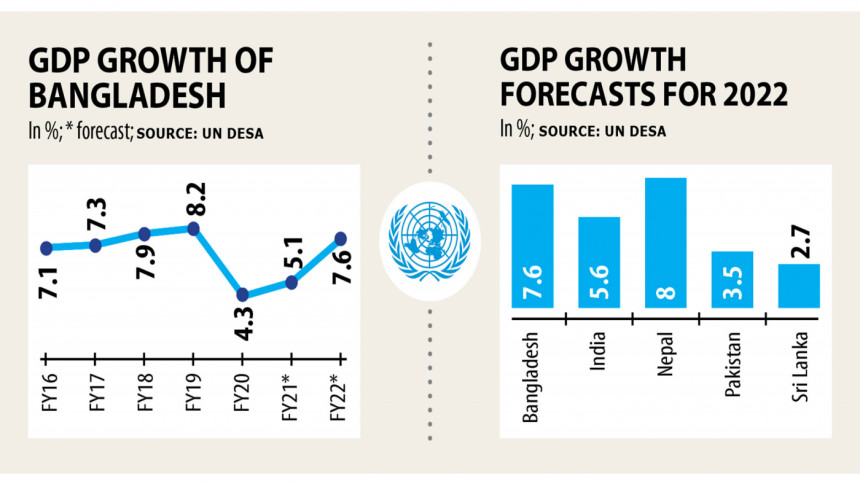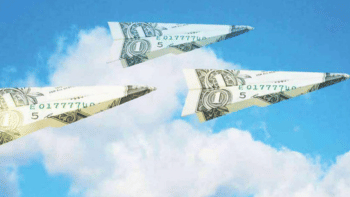Economy will return to high growth path next fiscal year: UN

Bangladesh's economy will return to the high growth trajectory in the next fiscal year overcoming the scarring impacts of the coronavirus pandemic, according to a United Nations report.
The country's gross domestic product (GDP) will grow by 7.6 per cent in the fiscal year of 2021-22 following a 5.1 per cent expansion in the current fiscal year, said the World Economic Situation and Prospects 2021 report produced by the United Nations Department of Economic and Social Affairs.
The UN forecast is higher than the projection made by the World Bank and is in line with that of the International Monetary Fund (IMF).
The WB has said Bangladesh's economy will expand by 3.4 per cent in the FY22 from 1.6 per cent in the current fiscal year. The IMF has forecast 7.9 per cent growth in the FY22.
The government has lowered the GDP growth projection for the current fiscal year to 7.4 per cent taking into account the fallouts of the coronavirus pandemic.
Achieving resilience to external shocks should be among the most important considerations within the decision framework for policymakers in South Asia who are currently rethinking their industrial policies, the report said.
The report urged the policymakers in South Asia to strengthen their efforts to formalise labour markets and strengthen their social protection systems to dampen the impact of the crisis on the most vulnerable and improve macroeconomic resilience.
Informal workers account for more than 80 per cent of workers in Bangladesh, India and Pakistan and they have been far more exposed to the loss of employment than formal workers during the crisis.
South Asia's widespread informality has almost certainly magnified the impact of the pandemic.
The Covid-19 fiscal response in South Asia has consisted of a vast ad hoc expansion of social assistance and direct cash transfers for the neediest, but this kind of special support is neither sufficient nor sustainable.
Policymakers in South Asia, taking stock of recent lessons, will, therefore, have to design their social protection systems with a view to rendering them more inclusive, especially for those in the informal sector, and more flexible and resilient, the UN Desa said.
However, they will need significantly more fiscal space to achieve all of these goals.
While increased domestic revenue mobilisation can make up for some of the shortfalls, both bilateral and multilateral creditors will still need to adopt a concessionary stance to avert protracted debt crises in an already deeply wounded region.
Several South Asian countries ran fiscal deficits of about 10 per cent of GDP in 2020, and government debt is forecast to grow significantly for most countries.
"Yet, fiscal austerity is not desirable until South Asian countries are back at or close to their economic growth potential, which might still take several years," the report said.
Economic growth in South Asia in 2021 will be insufficient, at 6.9 per cent, to make up for the losses of 2020, as pandemic hotspots re-emerge and, increasingly, the ability of governments to deal with the multitude of challenges becomes exhausted, the UN report said.
While trade, remittances and investment are expected to pick up in 2021, as much of the global economy moves towards recovery from the widespread lockdown, investment and domestic consumption in many South Asian countries will nevertheless remain subdued owing to the continuing threat of the pandemic and the scarring effects of the crisis.
South Asian countries that are relatively more exposed to global economic conditions, such as Bangladesh and the Maldives with their high share of foreign trade and Nepal with its dependence on tourism and remittances, will enjoy a stronger rebound.
The recovery is subject, however, to significant risks. The forecasts assume effective containment of the virus in South Asia and the rest of the world, including no further lockdowns in 2021, the resurgence of global trade, and the effective continuation of fiscal stimulus and containment efforts in South Asia and other regions.
"Failure of any or all of these base-line assumptions to materialise could plunge the region deeper into crisis. Opportunities exist as well, but they are less likely and would be less impactful than the downside risks."
The agency said the development of new growth sectors, aided by targeted fiscal stimulus and the disruptive effects of the crisis, could propel South Asia's development trajectory and allow the region to make up lost ground much more quickly.
"A forceful global commitment to counter the negative consequences of the pandemic, particularly in developing countries, could also allow the region to build back better and stronger and regain its position as the global development champion."
But to grow back stronger, South Asian countries will need first to redouble their efforts to diversify their economies, while at the same time taking stock of global trends initiated by the crisis, such as reshoring of global value chains (GVCs) and a decreased appetite for contact-intensive services.
The report said economic diversification is low or minimal in many South Asian economies, with the near single-trade economies of Bangladesh (garments), Iran (oil) and the Maldives (tourism) especially exposed to external demand shocks.
Garment shipment accounts for more than 80 per cent of annual exports of Bangladesh.
"South Asian governments should promote, in particular, the development of more complex, high-skills and high value-added sectors that could reach a broader base of trade partners within and outside of South Asia or even the domestic market," the UN agency said.



 For all latest news, follow The Daily Star's Google News channel.
For all latest news, follow The Daily Star's Google News channel. 



Comments